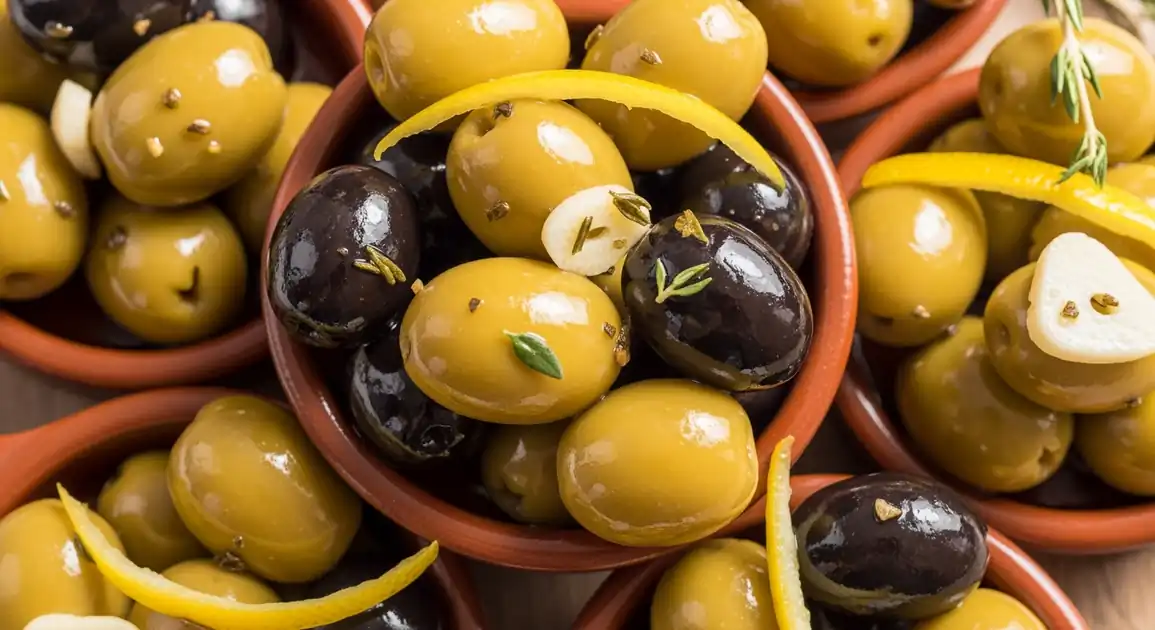Aceitunas Aliñadas (Marinated Olives)
Aceitunas Aliñadas

Description
Seville, as the heart of Andalusia, is a paradise for olive lovers. The region is a world leader in olive production, particularly the famous Manzanilla and giant Gordal varieties. Aceitunas aliñadas are an absolute staple in every tapas bar, showcasing fresh, local olives prepared with traditional Andalusian marinades.
Dietary Information
Serving information
Serving style
Served in small earthenware dishes ('cazuelitas'). Manzanilla and Gordal are the stars. Pits usually left in.
Quick facts
Bars open from lunchtime (around 12 PM/1 PM) until late. Markets open mornings until early afternoon (around 2 PM/3 PM).
Safety Tips
What to Look For
-
Plump, vibrant appearance
Indicates freshness and good quality olives. Color should be appropriate for the type.
-
Clear, clean marinade
The olive oil or brine should not look cloudy, dirty, or have scum on top.
-
Fresh, pleasant aroma
Should smell invitingly of olives, garlic, and herbs. Avoid sour, rancid, or fermented smells.
-
Reputable source
Busy bars, specialized market stalls, or trusted brands indicate better quality control and freshness.
-
Clean serving dish/container
Basic hygiene indicator for how the olives are stored and served.
What to avoid
-
Mushy or excessively soft texture
Can indicate spoilage or poor quality olives.
-
Dull color or visible mold/spots
Clear signs of spoilage; do not eat.
-
Cloudy, foamy, or dirty-looking brine/oil
Suggests contamination or that the olives have been sitting for too long improperly stored.
-
Rancid oil smell or sour/fermented odor
Indicates spoilage. Trust your senses.
-
Uncovered olives exposed to flies/dust
Especially relevant at markets or outdoor stalls. Choose covered or protected olives.
Price information
Price range
Budget tips
- Prices are generally very reasonable due to local abundance.
- Complimentary olives with a drink are still sometimes offered, though less guaranteed than in smaller towns.
- Markets like Mercado de Triana offer great value for buying olives by weight.
Value indicators
- Plumpness, especially of Gordal olives.
- Fresh garlic and herb flavors in the marinade.
- Use of local Manzanilla or Gordal olives.
- Offered in traditional neighborhood bars ('bares de barrio').
Where to Find This Dish
Triana
Famous neighborhood across the river, known for its traditional tapas bars and ceramics, great place for authentic olives.
Puente de Triana, Calle Betis, Mercado de Triana
Lunchtime, Evening
Santa Cruz
Historic Jewish quarter, touristy but has some hidden gem bars serving traditional tapas including olives.
Seville Cathedral, Alcázar, Narrow winding streets
Lunchtime, Evening
Alfalfa / Centro
Busy central area with numerous bars and restaurants serving tapas.
Plaza de la Alfalfa, Plaza Nueva, Calle Sierpes
Lunchtime, Evening
Mercado de Triana / Mercado de Feria
Excellent markets with stalls selling high-quality local olives with various 'aliños'.
Mercado de Triana, Calle Feria (for Mercado de Feria)
Morning (for markets)
Vendor Tips
- Seek out bars favored by locals rather than just tourist traps for the best experience.
- Specifically ask for 'Gordal' olives to try the large, fleshy local variety.
- Mercado de Triana is great for seeing and buying a wide variety of local olives.
- Pair with a local Manzanilla sherry or a Cruzcampo beer.
How to Order
Regional Variations
-
Aceitunas Gordal Aliñadas
(Aceitunas Gordal Aliñadas)
The large 'Queen' olives marinated, often simply to highlight their size and meaty texture.
-
Aceitunas Manzanilla Aliñadas
(Aceitunas Manzanilla Aliñadas)
The smaller, crisp green olives, typically with a more flavorful marinade.
-
Aceitunas Machacadas Sevillanas
(Aceitunas Machacadas Sevillanas)
Cracked green olives marinated in a traditional Seville style, often involving garlic, paprika, cumin, oregano, and sometimes bitter orange peel.
-
Aliños with Orange Peel
(Aliños con Piel de Naranja)
The use of local Seville orange peel in marinades adds a distinctive aromatic bitterness.
Cultural context
History
Olive cultivation has shaped the Spanish landscape and cuisine for millennia, dating back to Phoenician and Roman times. The practice of curing and marinating olives is equally ancient, developed as a preservation method and a way to enhance flavor. Regional 'aliños' (marinades) evolved based on local ingredients and traditions. The integration of olives into the tapas ritual solidified their place as an indispensable element of Spanish social eating and hospitality.
Local significance
Olives are intrinsically linked to Seville and Andalusian identity. They represent the agricultural wealth of the region and the simple pleasures of its tapas culture.
Eating customs
- Consumed casually at the bar counter or small tables.
- Sharing a 'ración' of olives among friends is common.